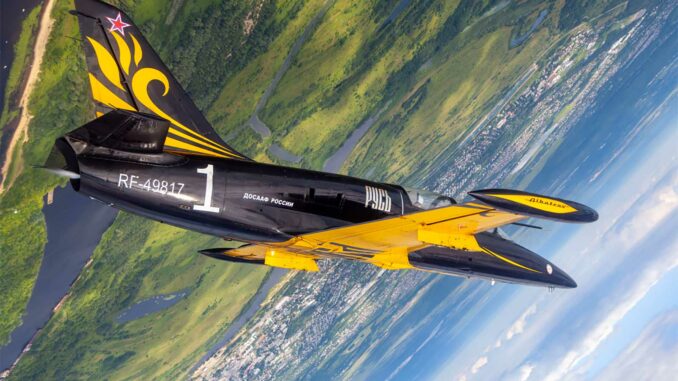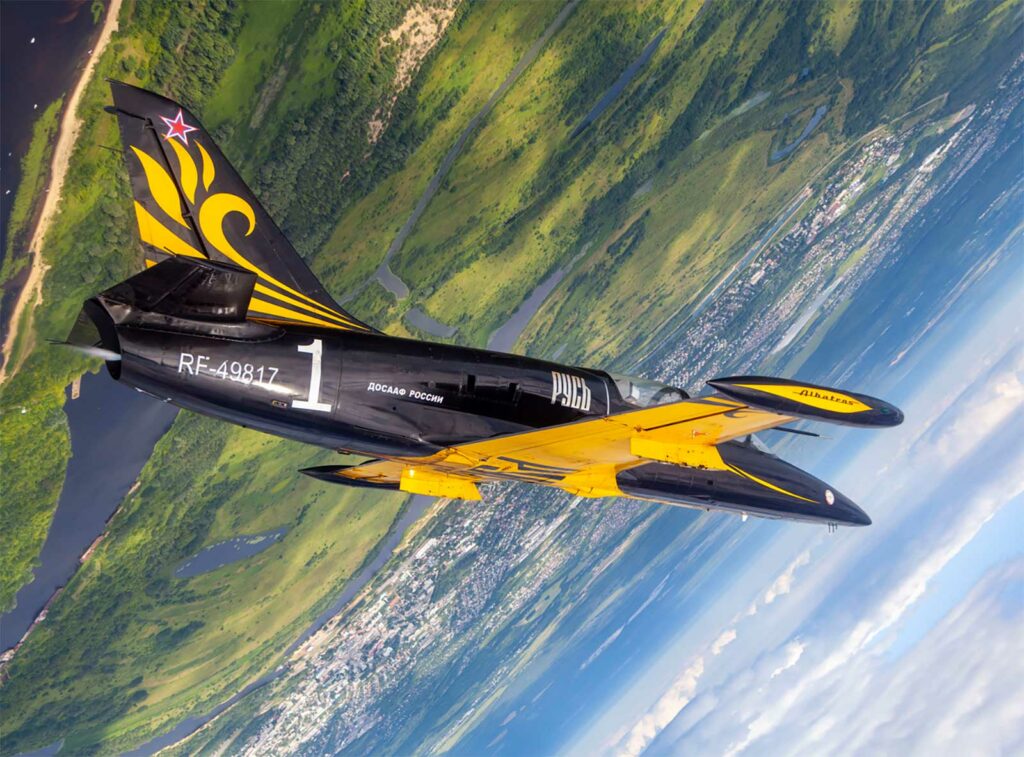
The L-39 Albatros from Aero Vodochody: origins, missions, key figures, L-39NG variants, and civilian uses of L-39 flight. Technical and market analysis.
Summary
Designed by Aero Vodochody in the late 1960s, the L-39 Albatros became the benchmark jet training aircraft for the Eastern Bloc, and then for more than 30 air forces. The world’s first trainer equipped with an AI-25TL turbofan, it standardized the teaching of high-speed combat maneuvers and served, depending on the version, as a light support and reconnaissance platform. Approximately 2,900 units were produced. Its dimensions (12.13 m long, 9.46 m wingspan) and maximum speed of around 750–755 km/h in “clean” configuration make it a formidable value for money for advanced training. Since 2014, the L-39NG program has been modernizing the entire aircraft (airframe, avionics, Westernized engine), with Czech military certifications and variants intended for training 4th/5th generation pilots. Beyond the military, private operators offer L-39 flights with aerobatic profiles, simulating a short mission in a controlled environment. The result is an aircraft that is both heritage and current, relevant for the transition of students to modern fighters (Gripen, Rafale, F-16V), and with a lasting presence in the training and civil “warbird” markets.
Origin and objectives: a standard for fast and effective training
Originally, Czechoslovakia needed to replace the L-29 Delfín with a more efficient, easy-to-use, and economical aircraft. The specifications called for a tandem two-seater platform capable of reproducing the dynamic regimes of a fighter while remaining forgiving for the student. The choice of the AI-25TL (Ivchenko/Progress) turbofan engine was decisive: it offered better specific efficiency, reduced noise, and a more linear engine response than a pure turbojet, which improved safety at low speeds and low altitudes. The first flight took place in 1968, and its introduction in 1972 to Warsaw Pact users triggered a series of orders. The strategic objective was clear: to harmonize training programs, reduce the cost per flight hour, and facilitate the move up to supersonic aircraft.
Operationally, the instructor had extended visibility and redundant controls, while the student had a clear analog cockpit, similar to the instrument panels of the fighter jets of the time. The robust landing gear could handle secondary runways, and the thick right wing offered good low-speed performance, which was essential for the “long” landings of young pilots. The aircraft can withstand load factors typical of combat training (+8/-4 g), allowing for loops, barrel rolls, inversions, and rapid transitions between phases. Finally, the logistics are designed for a network of dispersed bases: accessible engine, standardized parts, and rugged airframe. The combination of these parameters—sufficient performance, docility, and easy maintenance—explains the rapid spread of the L-39 in flight schools and its longevity.
Design and performance: dimensions, envelope, and missions
The L-39 Albatros is 12.13 m long, with a wingspan of 9.46 m and a height of 4.77 m, for a wing area of 18.9 m². This geometry provides satisfactory stability at medium altitude and a comfortable stall margin (typical stall speed ~169 km/h), which is crucial for training purposes. The maximum speed in level flight is around 750–755 km/h, with a practical ceiling of around 11,000 m and a climb rate of around 22 m/s (≈ 1,320 m/min). The standard range exceeds 1,100 km, allowing for long flights or extended training windows over a polygon.
The wide and robust tricycle landing gear allows for operations on secondary runways; ground clearance remains sufficient to carry external loads on armed versions (ZO/ZA): rockets, low-mass smooth bombs, GSh-23 gun pods on the ZA. The fuel system supplies the turbofan via internal tanks and, depending on the configuration, underwing fuel tanks. The original avionics are analog; upgrades add VOR/ILS, GPS/INS, modern radios and, on recent versions, multifunction displays.
The airframe can handle a variety of profiles: circuit flying, basic flight, aerobatics, navigation, low altitude, simulated interception and light air-to-ground firing on firing ranges. The simplicity of the “training aircraft” cargo hold reduces costs and makes maintenance safer. In terms of safety, the redundancy of the controls and the permissive thermal management of the AI-25TL limit incidents during the student phase. The whole package is a technical compromise designed for “learning to fight” without unnecessary complexity, with a flight envelope wide enough to expose trainees to the key operating modes of a fighter while maintaining recovery margins.
Advanced training and mission simulation: from maneuvers to tactics
The core value of the L-39 lies in advanced training. Schools use it to reinforce the fundamentals: energy management (Ps curves), axis control during rolls, instantaneous/sustained turns, simulated failures, and emergency procedures. At 500–600 km/h, students learn to manage the cognitive load: looking outside, planning maneuvers, anticipating the load factor, and maintaining parameters (speed/altitude/heading) under stress. Aerobatics sessions discipline “right hand/left hand” coordination and finesse at the controls.
Air-to-air combat simulation (basic BFM) is carried out via nose presentations, “one-circle/two-circle,” debriefed using flight recorders. The instructor then introduces low-altitude navigation, terrain and wind management, followed by an introduction to tactical procedures (SPI, level attack, escape). The realistic objective is not to turn them into “fighters” on the L-39, but to lock in the mechanical and mental skills needed to switch to a front-line aircraft.
For armies with limited resources, “multi-role” use (training + light support + reconnaissance) has long made it possible to pool fleets. In practice, a patrol of two L-39s with reconnaissance pods or rockets can provide rapid intelligence or precision support against lightly defended targets. Attrition rates, which have historically been low, are due to the ruggedness of the airframe and the predictability of the engine. Finally, the cockpit ergonomics—tandem seating, good visibility—facilitate training: debriefing based on comparable mental images, immediate corrections, and effective skills transfer. It is precisely this “school of correct technique” that has made the L-39’s reputation.
International adoption and operational use: distribution and feedback
With nearly 2,900 aircraft produced between 1971 and 1996, distribution extended beyond Eastern Europe to North Africa, the Middle East, Central and Southeast Asia, and Latin America. More than 30 air forces have operated it, some for military aerobatics or aerobatic teams. This volume has created a favorable ecosystem: parts stocks, MRO expertise, avionics upgrades, glass cockpit conversions, and NATO radio compatibility.
Operationally, reconnaissance and light support roles have been performed in various theaters, with the inherent limitations of a subsonic, non-stealth aircraft: vulnerability to modern threats (IR-guided SHORAD, MANPADS) and the need for prior local air superiority. In limited-scale air policing or border surveillance scenarios, however, its low fuel consumption and ease of deployment have enabled extended patrols at low cost, which are useful for “holding” airspace in peacetime.
In terms of training, the ease of transitioning to contemporary fighters has been regularly highlighted: students who have mastered energy/attitude on the L-39 are quicker to find their feet on an F-16, Gripen or Mirage 2000, saving expensive flight hours on combat fleets. In budgetary terms, the hourly cost of an L-39 remains well below that of a Hawk, an M-346 or an entry-level fighter; this is a decisive argument for constrained air forces that need to train quickly, effectively and at the lowest total cost of ownership.

Evolution, from variants to the L-39NG program: modernizing without compromising
The family tree includes the L-39C (trainer), the L-39V (target tug), the L-39ZO (reinforced wing, 4 hardpoints) and the L-39ZA (GSh-23 cannon in nacelle). It will then lead to the L-159 ALCA, a more combat-proven single-engine jet equipped with Western avionics. But the real successor to the “training” aircraft emerged in 2014 with the L-39NG: redesigned airframe, modernized electronics (glass cockpit, GPS/INS, NATO-compatible links depending on version), and Williams FJ44-4M engine. The objective is to maintain educational relevance in the face of 4th/5th generation fighters, while reducing maintenance and specific fuel consumption.
In terms of certification, the L-39NG has received Czech military validation and type extensions for training variants (T1), paving the way for contracts in Central Europe and “mixed” fleets (renovation of old L-39s + new aircraft). Replacing the AI-25TL turbofan with an FJ44 reduces noise and improves efficiency, a key factor for bases close to urban areas and for technical availability. Western/Eastern options allow radios, cryptos, and mission systems to be adapted to the customer’s ecosystem.
In terms of the market, Aero Vodochody‘s strategy is rational: capitalize on a global fleet that is still in use (≈ 700 aircraft in civil and military service), offer avionics upgrades, while delivering new NGs to schools that want a competitive cost per hour compared to Italian or British alternatives. Compatibility with modern simulators and CBTA (Competency-Based Training and Assessment) syllabuses reinforces the educational value proposition.
Civilian use and the “warbird” experience: what passengers experience
Beyond the military, flying in an L-39 has become part of the civilian “warbird” offering. Supervised by qualified pilots (often former military personnel), the typical flight lasts 30 to 50 minutes. After a safety briefing and equipment check (jumpsuit, helmet microphone, oxygen mask if necessary), the passenger takes their seat in the rear, with basic instruments visible. The flight begins with gentle maneuvers to test g-tolerance and anti-g breathing, then moves on to progressive maneuvers: loops, rolls, inversions, Immelman turns, and possibly a low-level run if local regulations allow. Target loads vary from +3 to +6 g depending on the individual’s ability; the airframe limit is close to +8/-4 g (a margin not reached during a first flight).
The educational value is not insignificant: feeling acceleration, inertia, stick/pedal coordination, understanding why a speed indicator decreases during climb and how to manage energy during a rollover. In terms of health and safety, the selection of weather conditions, the proximity of an open field, and the availability of emergency procedures (aborted takeoff, return to field) are non-negotiable. The “mission” aspect may include a short “tactical navigation” exercise or a simulated attack on a fictitious target, all within a strict regulatory framework.
In terms of cost, operators charge for flight time and associated services (pre-flight, fuel, passenger insurance). Depending on the airfield and country, the cost is generally in the range of a few thousand euros per short mission (including currency conversion), which reflects the jet fuel consumption, maintenance, and specific insurance premiums. For an informed audience, this is a realistic introduction to combat aviation—without claiming to train a pilot, but by conveying the sensations and vocabulary common to military aviation.
War Wings Daily is an independant magazine.